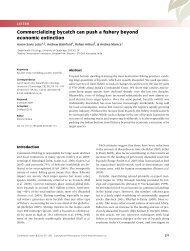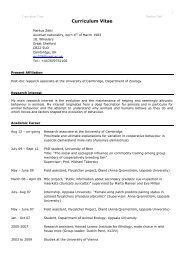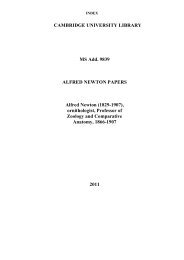Annual Report 2009 - Department of Zoology - University of ...
Annual Report 2009 - Department of Zoology - University of ...
Annual Report 2009 - Department of Zoology - University of ...
You also want an ePaper? Increase the reach of your titles
YUMPU automatically turns print PDFs into web optimized ePapers that Google loves.
Research in the <strong>Department</strong><br />
The <strong>Department</strong>’s research activities are organised into eight research groups, including <strong>Department</strong> members <strong>of</strong> the<br />
Wellcome Trust/Cancer Research UK Gurdon Institute <strong>of</strong> Cancer and Developmental Biology. The following pages briefly<br />
summarise each group’s research interests and members, and highlight a piece <strong>of</strong> research carried out in <strong>2009</strong>.<br />
Animal Physiology<br />
The Animal Physiology Group’s greatest strength is<br />
in comparative animal physiology, <strong>of</strong>fering a breadth<br />
<strong>of</strong> expertise and graduate training for a wide range <strong>of</strong><br />
techniques, focusing on the model systems provided by<br />
arthropods and vertebrates. Research is conducted at a<br />
number <strong>of</strong> different levels <strong>of</strong> biological organisation, from<br />
biochemical and tissue to organismal and ecological, and<br />
includes a mixture <strong>of</strong> laboratory and field-based studies. We<br />
aim to understand the structural and functional capacities<br />
<strong>of</strong> organisms, their abilities to respond to environmental<br />
extremes, and how physiological adaptations to locomotion,<br />
activity metabolism and ion transport have arisen through evolutionary time. Charlie Ellington studies the aerodynamics,<br />
mechanics and physiology <strong>of</strong> insect flight, within the broader field <strong>of</strong> biomechanics. Simon Maddrell studies epithelial<br />
transport <strong>of</strong> insect Malpighian tubules and its control by peptides and other blood-borne agents. Walter Federle<br />
investigates the physical ecology <strong>of</strong> insect-plant interactions and the mechanisms <strong>of</strong> surface adhesion in animals.<br />
Ulrike Bauer: Plant-animal interactions in Nepenthes<br />
pitcher plants<br />
James Bullock: Design and function <strong>of</strong> fibrillar adhesive<br />
systems in insects<br />
Christ<strong>of</strong>er Clemente: Evolution <strong>of</strong> lizard locomotion, insect<br />
biomechanics<br />
Kristin De-Clercq: Fluid membrane-interaction in flapping<br />
flight<br />
Jan-Henning Dirks: Fluid-based adhesion in insects<br />
Thomas Endlein: Locomotion and adhesion in ants<br />
Insect adhesive pads are self-cleaning<br />
Walter Federle<br />
Many insects, spiders, frogs and lizards have special organs on their legs that<br />
allow them to cling to smooth vertical or inverted surfaces as found on plants.<br />
A major problem for everyday adhesives such as sticky post-it notes is that<br />
they accumulate dust and lose adhesion when used more than a few times.<br />
However, animals must keep their pads sticky over millions <strong>of</strong> steps in a lifetime.<br />
They could achieve this either by diligent cleaning with their mouthparts or more<br />
elegantly by self-cleaning properties <strong>of</strong> the pads themselves.<br />
Chris Clemente, Part II student Andrew Beale, James Bullock and Walter<br />
Federle studied how smooth pads <strong>of</strong> stick insects (Carausius morosus) and hairy<br />
pads <strong>of</strong> beetles (Gastrophysa viridula) are affected by contamination. Using<br />
microspheres <strong>of</strong> different diameters, we found that both types <strong>of</strong> pads exhibit<br />
self-cleaning. Even when fully contaminated, pads recovered high levels <strong>of</strong><br />
adhesion over only eight simulated steps. Self-cleaning was strongly enhanced<br />
by shear movements, and only the beetles’ hairy pads were able to selfclean<br />
during purely perpendicular pull-<strong>of</strong>fs. Hairy pads also self-cleaned more<br />
efficiently than smooth pads for large (45 µm) and small (1 µm) particle sizes. However, the beetles’ self-cleaning was<br />
much slower when contaminated with intermediate-sized (10 µm) beads. This limitation <strong>of</strong> self-cleaning was explained<br />
by the coincidence <strong>of</strong> bead diameter and inter-seta distance, which caused the beads to remain trapped between setae.<br />
Further work will now address the underlying mechanisms <strong>of</strong> self-cleaning.<br />
11<br />
Yanjia Gao: The control algorithm and stability <strong>of</strong> flight in<br />
insects and MAVs<br />
Jamie Gundry: Aerodynamics <strong>of</strong> hoverfly flight<br />
Karin Moll: Biomechanics <strong>of</strong> the foraging behaviour in<br />
grass-cutting ants<br />
Sean Ng: Laminar-turbulent transition in animal flight<br />
Anne Peattie: Fibrillar adhesion in spiders<br />
Jay Riegel: Fluid transport across tissues<br />
Dan Thornham: Nepenthes pitcher traps and<br />
counteradaptations <strong>of</strong> specialised ants<br />
Hairy adhesive pads <strong>of</strong> dock beetle<br />
(Gastrophysa viridula) contaminated by<br />
45-µm latex beads





